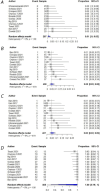Particle embolic agents for embolization of middle meningeal artery in the treatment of chronic subdural hematoma: A systematic review and meta-analysis
- PMID: 36112765
- PMCID: PMC10956449
- DOI: 10.1177/15910199221125977
Particle embolic agents for embolization of middle meningeal artery in the treatment of chronic subdural hematoma: A systematic review and meta-analysis
Abstract
Objective: In this systematic review and meta-analysis, we investigated the efficacy and safety of middle meningeal artery embolization (MMAE) using particle embolic agents to treat cSDH.
Methods: To retrieve articles investigating outcomes of patients following MMAE with particle agents and to compare their outcome with conventional treatment, Scopus, PubMed, Embase, and Web of Science were searched using relevant keywords. Original articles with more than 10 cases were included. The meta-analysis was carried out using the R studio and the random-effects model. Publication bias was assessed using Peter's test and quality assessment using NIH tools.
Results: Eleven studies with 359 patients were included. The analysis revealed a pooled recurrence rate of 5% (CI: 3-8%), a need for reoperation rate of 5% (3-9%), and a peri-procedural complication rate of 4% (CI:2-9%) following MMAE with particle embolic agents. The pooled rates of decrease in size or resolution of the hematoma were 85% (CI:66-94%) and 66% (39-86%), respectively. Comparing MMAE using particulate embolysate with conventional treatments, risk ratio (RR) of 0.10 (CI:0.04-0.27) was achieved for recurrence, 0.25(CI:0.13-0.49) for reoperation, and 0.34 (CI:0.16-0.27) for peri-procedural complications. 91% of cSDH cases responded to MMAE with particles in the way they showed either down-sizing or complete resolution of the hematoma on follow-up imaging. In comparison, this rate was found to be 63% following conventional treatment.
Conclusion: Middle meningeal artery embolization using particle embolysates is a safe and effective technique for the treatment of cSDH, whether as a standalone intervention or in combination with conventional treatments.
Keywords: Middle meningeal artery embolization; chronic subdural hematoma; particle embolization agents.
Figures




Similar articles
-
Middle Meningeal Artery Embolization with Liquid Embolic Agents for Chronic Subdural Hematoma: A Systematic Review and Meta-analysis.J Vasc Interv Radiol. 2023 Sep;34(9):1493-1500.e7. doi: 10.1016/j.jvir.2023.05.010. Epub 2023 May 12. J Vasc Interv Radiol. 2023. PMID: 37182671
-
Adjunct middle meningeal artery embolization versus surgery alone for chronic subdural hematoma: A meta-analysis and trial sequential analysis of randomized controlled trials.J Clin Neurosci. 2025 Jul;137:111307. doi: 10.1016/j.jocn.2025.111307. Epub 2025 May 12. J Clin Neurosci. 2025. PMID: 40359787 Review.
-
Middle meningeal artery embolization for chronic subdural hematoma: meta-analysis of three randomized controlled trials and review of ongoing trials.Acta Neurochir (Wien). 2025 Jun 10;167(1):166. doi: 10.1007/s00701-025-06587-4. Acta Neurochir (Wien). 2025. PMID: 40493076 Free PMC article.
-
Comparative analysis of Onyx, squid, and n-BCA in middle meningeal artery embolization for chronic subdural hematoma: a meta-analysis of randomized controlled trials.Neuroradiology. 2025 Jun;67(6):1557-1566. doi: 10.1007/s00234-025-03651-9. Epub 2025 May 20. Neuroradiology. 2025. PMID: 40392287 Review.
-
Middle meningeal artery embolization alone versus combined with conventional surgery in the management of chronic subdural hematoma: A systematic review and meta-analysis.Clin Neurol Neurosurg. 2024 Nov;246:108580. doi: 10.1016/j.clineuro.2024.108580. Epub 2024 Oct 3. Clin Neurol Neurosurg. 2024. PMID: 39395281
Cited by
-
Newer treatment paradigm improves outcomes in the most common neurosurgical disease of the elderly: a literature review of middle meningeal artery embolization for chronic subdural hematoma.Geroscience. 2024 Dec;46(6):6537-6561. doi: 10.1007/s11357-024-01173-5. Epub 2024 May 1. Geroscience. 2024. PMID: 38691299 Free PMC article. Review.
-
Cost comparison of liquid versus particulate embolic agents for middle meningeal artery embolization in chronic subdural hematoma.Interv Neuroradiol. 2025 Aug 12:15910199251362080. doi: 10.1177/15910199251362080. Online ahead of print. Interv Neuroradiol. 2025. PMID: 40791086 Free PMC article.
-
Therapeutic efficacy of drilling drainage combined with intraoperative middle meningeal artery occlusion in the management of chronic subdural hematoma: a clinical study.Neurosurg Rev. 2024 Jun 25;47(1):293. doi: 10.1007/s10143-024-02501-1. Neurosurg Rev. 2024. PMID: 38914867 Free PMC article. Clinical Trial.
-
Extensive Roles and Technical Advances of Middle Meningeal Artery Embolization for Chronic Subdural Hematoma.Neurol Med Chir (Tokyo). 2023 Aug 15;63(8):327-333. doi: 10.2176/jns-nmc.2023-0017. Epub 2023 Jun 8. Neurol Med Chir (Tokyo). 2023. PMID: 37286481 Free PMC article. Review.
-
Role of nanotechnology in neurosurgery: A review of recent advances and their applications.World Neurosurg X. 2024 Feb 24;22:100298. doi: 10.1016/j.wnsx.2024.100298. eCollection 2024 Apr. World Neurosurg X. 2024. PMID: 38455250 Free PMC article. Review. No abstract available.
References
-
- Feghali J, Yang W, Huang J. Updates in chronic subdural hematoma: epidemiology, etiology, pathogenesis, treatment, and outcome. World Neurosurg 2020; 141: 339–345. - PubMed
-
- Holl DC, Volovici V, Dirven CM, et al. Pathophysiology and nonsurgical treatment of chronic subdural hematoma: from past to present to future. World Neurosurg 2018; 116: 402–11. e2. - PubMed
-
- Suzuki M, Endo S, Inada K, et al. Inflammatory cytokines locally elevated in chronic subdural haematoma. Acta Neurochir 1998; 140: 51–55. - PubMed
-
- Hohenstein A, Erber R, Schilling Let al. et al. Increased mRNA expression of VEGF within the hematoma and imbalance of angiopoietin-1 and-2 mRNA within the neomembranes of chronic subdural hematoma. J Neurotrauma 2005; 22: 518–528. - PubMed
Publication types
MeSH terms
LinkOut - more resources
Full Text Sources

